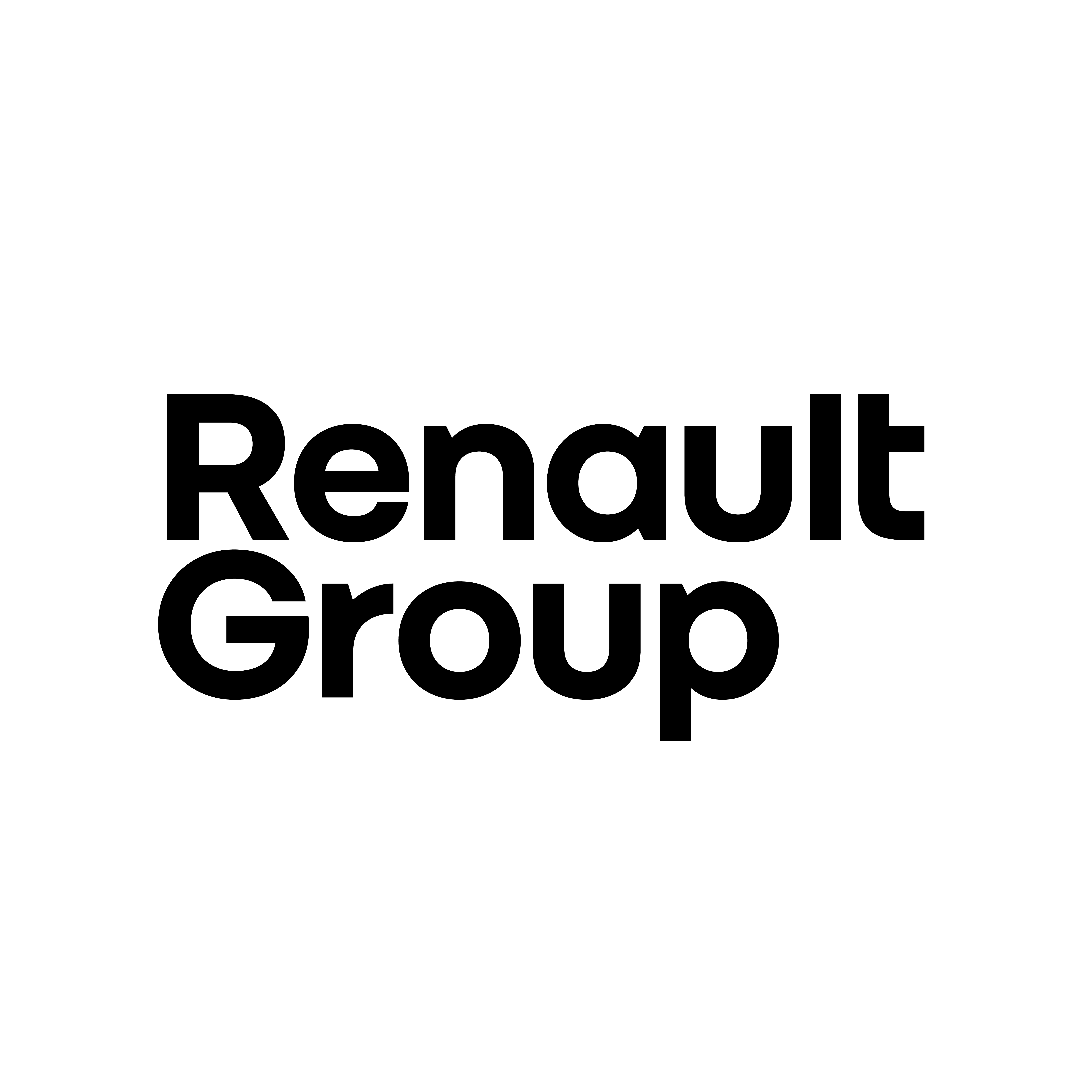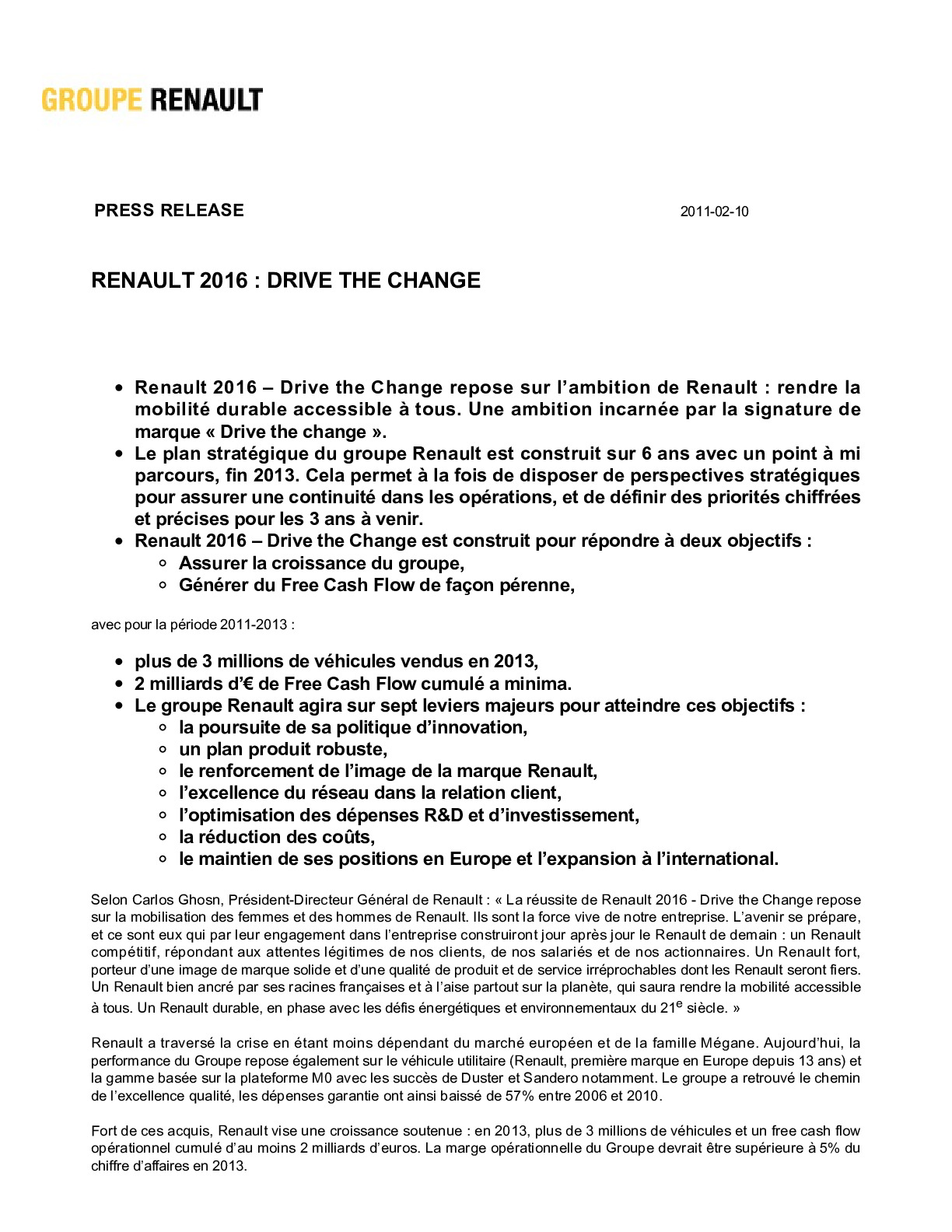Renault 2016 – Drive the change
10 February 2011 07:46
- Renault 2016 – Drive the Change is founded on Renault’s ambition to make sustainable mobility accessible to all, expressed in the brand tagline, “Drive the Change”.
- This strategic plan covers a six-year period with a mid-term review at the end of 2013. This will allow us to build a long-term strategic outlook to ensure continuity in operations and to establish precise, quantified priorities for the three years to come.
-
Renault 2016 – Drive the Change has been built to meet two objectives:
- ensure the Group’s growth,
- generate free cash flow on a lasting basis,
with the following aims for the 2011-2013 period:
- sales of over 3 million vehicles in 2013,
- at least €2 billion in aggregate free cash flow.
-
The Renault group will work on seven key levers to meet these objectives:
- pursue the innovation policy,
- strengthen the product offer,
- reinforce the image of the Renault brand,
- ensure the excellence of the distribution network in customer relations,
- control investment and R&D expenditure,
- reduce costs,
- maintain positions in Europe and pursue growth internationally.
Commenting, Carlos Ghosn, Chairman and Chief Executive Officer of Renault, said: “The success of Renault 2016 - Drive the Change relies on the mobilization and engagement of the men and women of Renault throughout the world. They are the key to the company’s future. It is their commitment that will contribute to building day after day the Renault of tomorrow. A more competitive Renault meeting stakeholders’ expectations. A strong Renault with a powerful brand image and a benchmark level of quality and services that will make all our employees proud. A Renault established in its French roots and at ease all over the world, making mobility affordable for all everywhere. A sustainable Renault in line with the energy and environmental challenges of the 21 st century.”
Renault weathered the crisis by being less reliant on the European market and the Mégane family. The Group’s performance today also relies on light commercial vehicles (a segment in which the Renault brand has been the European leader for 13 years) and the range based on the M0 platform, with the successes of Duster and Sandero in particular. The Group has returned to the path of quality excellence with warranty costs falling 57% between 2006 and 2010.
With these strengths, Renault is aiming for sustained growth, namely sales of over three million vehicles and aggregate automotive operational free cash flow of at least €2 billion in 2013. The Group’s operating margin objective is to exceed 5% of revenues in 2013.
A new policy of dividend payments will be proposed to Renault’s Board of Directors, which will submit each year a resolution to the Annual Shareholders’ Meeting. The policy will consist of two components:
- dividends received from associated companies will be paid systematically the following year to Renault shareholders,
- an additional dividend on the basis of automotive operational free cash flow may be added to that sum based on the economic environment and Renault’s financial situation.
SEVEN LEVERS FOR MEETING THE OBJECTIVES OF THE PLAN
1. Innovation to reduce the environmental impact of vehicles
Renault is innovating with electric vehicles
With its partner Nissan it aims to become the leader in zero-emission mobility, namely the first automaker to sell a complete range of electric passenger cars and light commercial vehicles at an affordable price for the greatest number. This year will be a decisive chapter in Renault history with the launch of three electric models, Fluence Z.E., Kangoo Z.E. and Twizy, followed by ZOE in 2012.
Renault is innovating with a new generation of combustion engines, “Energy”
The all-new 1.6 engine – “Energy dCi 130” – will be the most powerful engine on the market with this capacity and offer the best emissions/power ratio in its class. Fitted on Scénic and Grand Scénic from May 2011, it will reduce CO 2 emissions by 20% compared with the previous generation.
Renault’s new Energy TCe gasoline engines will cut CO 2 emissions for vehicles in the A, B and C segments by around 30% (or 40 g/km of CO 2 and one liter less fuel per 100 km).
These innovations will help reduce CO 2 emissions significantly. From 137 g/km today, Renault’s range in Europe will emit on average less than 120 g by 2013 and less than 100 g by 2016 with the electric vehicle.
2. A robust product plan
Mass marketing a complete EV range
With four electric vehicles by 2012 and further new models to follow from 2014 to 2016, Renault’s Z.E. range allied with Nissan’s should enable the Alliance to put a cumulative 1.5 million EVs on the road worldwide by 2016. From 2015 the Alliance will have a production capacity of 500,000 vehicles a year.
A broader and entirely renewed combustion-powered range between 2011 and 2016
Renault group brands will have 44 models in 2013 and 48 in 2016, compared with 40 in 2010 and 30 in 2005.
- In Europe, alongside the EV range, leading new models will be launched, such as Twingo phase 2 in 2011, new Clio in 2012 and, under the Dacia brand, a new family car and a small light commercial vehicle in 2012;
- Looking beyond Europe, we shall see a product range that is fully adapted to the needs of international markets. This is particularly true in the high-end range with Fluence, Latitude and SM7. Duster will also play a key role in sales growth outside Europe.
3. A stronger Renault brand
Renault aims to strengthen its image by relying on its distinctive advantages in the fields of innovation for all, quality and design.
Innovation for all
Renault history has been marked by innovations that are accessible to the greatest number, most recently with built-in navigation for less than €500 with Carminat TomTom. Electric vehicles are a perfect illustration of innovation for all, with a price tag and running costs equal to those of an equivalent diesel car.
Quality, a force to be recognized
Strengthening the brand is also based on Renault’s return to quality. All of today’s multi-brand surveys place Renault products among the best on quality, sometimes ahead of specialist carmakers. Renault is also in the top three on reliability. The Group’s objective is to make this better known and to rank among full-line manufacturers in terms of quality image by the end of 2013.
New Renault design
The DeZir concept car unveiled at the Paris Motor Show initiates Renault’s new design direction. The story continues with a series of concept cars, including the CAPTUR revealed today. The new phase of Twingo and new Clio will be the first range illustrations, all of them featuring the brand’s new styling focuses and cues, with an emphasis on warmth and sensuality.
4. Network excellence in customer relations
Renault is recognized in numerous countries (such as France and Spain) for its service quality. This quality now has to be extended worldwide and to all services, in sales, after-sales and sales financing. Starting this year Renault will also be launching network-wide the “Customer Promise”, which formalizes eight commitments including information on order status right through to delivery and guaranteed test drives of any range vehicle.
5. Optimizing investment and R&D expenditure
The Plan aims to maintain investment and R&D spend below 9% of revenues while increasing the Group’s geographical coverage and pursuing its innovation policy.
Shared platforms for more volume per platform and enhanced performance
- A new C/D platform will be shared with Nissan for mid- and upper-range models, leading to the production of 1.5 million vehicles a year.
- Renault and Daimler are to share the A platform to build future Twingo and Smart models.
- Renault’s light commercial vehicle platforms will benefit from agreements with Nissan and Daimler.
80% of the models launched between 2014 and 2016 will be based on a platform shared with a partner.
Parts standardized through modules
Renault is launching a new standardization approach based on the use of modules, consisting in designing parts from the start to be fitted on several different vehicles. The new policy will be applied first on the new M0 (Entry), B and C/D platforms.
6. Reduced costs to produce more competitive vehicles
Using monozukuri to reduce the direct cost of our vehicles by 4% a year
Renault launched the monozukuri approach in 2010 at four pilot sites and has now extended it to all Group plants. Introduced at Renault thanks to Nissan, monozukuri consists in working on the entire value creation chain, from design through to delivery to end customers, rather than function by function (purchasing, manufacturing, logistics, delivery). The method will lead to a 12% cut in direct costs between now and 2013.
Making better use of our production sites
Renault is adjusting capacity in Europe and increasing production internationally. Renault’s industrial sites will benefit from the Alliance and the strategic cooperation agreement with Daimler. These factors will by end-2013 bring about a 20-point increase in production capacity use at plants and improve the capacity use rate to over 100% worldwide.
7. Staying strong in Europe and growing internationally
Renault, No 2 brand in Europe
In a market with weak growth where household car budgets shrank by one quarter between 2000 and 2010, Renault intends to continue benefitting from the market shift to small cars and affordable technologies, and so maintain its positions in Europe.
Three international priorities: Brazil, India and Russia
By 2013 Brazil is expected to become Renault’s second-largest market, Russia its fourth – up five places and number one including Lada sales – and India its eleventh, up 20 places.
- Brazil: market share to remain above 5% on a lasting basis and three new models in 2011: Sandero phase 2, Fluence and Duster;
- Russia: market share set to reach 6% in 2013 (excluding Lada) with a broader range: Duster launched in 2012, plus a new M0 platform model in 2013 produced at Togliatti;
- India: launch of two new models, Koleos and Fluence, in 2011; an SUV in 2012; six new models localized in India in 2013.
OUTLOOK 2011
The global automotive market (PC+LCV) should grow by 6% compared to 2010. Trends by Region will continue to be contrasted. Markets outside Europe will remain dynamic while the European market should pursue consolidation (0% to -2%), notably with a decline in the French market of around -8%.
In this context, with the appeal of its internal-combustion vehicle range and the launch of a range of electric vehicles, unit sales and revenues in 2011 should be above 2010. The Group targets an automotive operational free cash flow above €500 million with a ratio of Capex + R&D at 9% of revenues.

